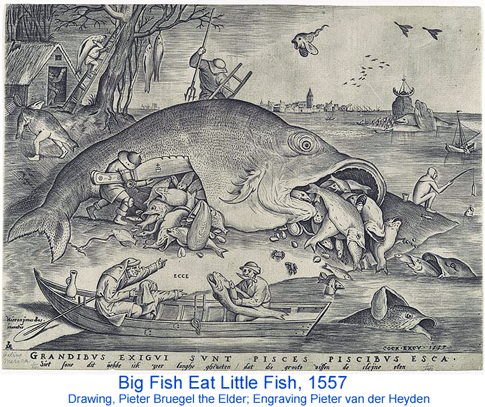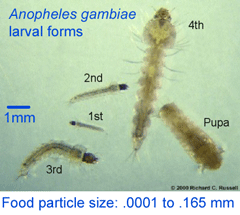As Bruegel the Elder recognized in 1557, “big fish eat little fish”. Determining exactly what eats what remains a fundamental question in modern ecology and this task is particularly challenging for biologists studying small organisms, which make up the bulk of the biomass in ecosystems. To add interest, a number of these tiny creatures with unknown diets are medically and/or economically important disease vectors.

In Mol Ecol Resources May 2008 researchers from University of California, Irvine, Kenya Medical Research Insitute, and Kanazawa University, Japan, apply DNA analysis identify gut contents of larval Anopheles gambiae complex mosquitoes, the major malaria vector in Africa.
 Authors Garros, Ngugi, Githeko, Tuno, and Yan collected anopheline larva near Kisumu in western Kenya, dissected stomach contents of third and fourth instar forms, extracted DNA, and amplified an 800 bp fragment of nuclear 18s rRNA. A separate PCR assay was used to confirm species identity (five were A. gambiae s.s. and 68 were sister species A. arabiensis). According to authors, 18s rRNA was analyzed rather than COI because “more sequences are available [for 18s than for COI] in databases for plants, fungi, and protists”. I note there are now many research groups working on “plants, fungi, and protists” so it should be possible to achieve greater resolution in this sort of study as the DNA barcode libraries are built up.
Authors Garros, Ngugi, Githeko, Tuno, and Yan collected anopheline larva near Kisumu in western Kenya, dissected stomach contents of third and fourth instar forms, extracted DNA, and amplified an 800 bp fragment of nuclear 18s rRNA. A separate PCR assay was used to confirm species identity (five were A. gambiae s.s. and 68 were sister species A. arabiensis). According to authors, 18s rRNA was analyzed rather than COI because “more sequences are available [for 18s than for COI] in databases for plants, fungi, and protists”. I note there are now many research groups working on “plants, fungi, and protists” so it should be possible to achieve greater resolution in this sort of study as the DNA barcode libraries are built up.
The PCR products from gut contents were first screened with a restriction endonuclease known to digest mosquito but not algal 18s. 355 PCR products from eight randomly selected larvae were screened, yielding 14 unique non-mosquito sequences. Best matches in GenBank blast results clustered into 3 main clades: green algae (7), fungi (5), and unknown eukaryotes (2). The authors conclude “the method presented in this study may be a promising tool to investigate natural diets of [anopheline] larvae”. Looking ahead, “such studies will not only improve our understanding of Anopheles larval ecology, but also provide fundamental information to facilitate the develpment of novel larval control tools.”
This study is one demonstration of how routine DNA analysis combined with expanding DNA barcode libraries will help reveal and monitor changes in a multiplicity of tiny food webs. More generally, routine DNA analysis combined with reliable DNA reference libraries opens wide avenues for rapid progress in understanding how the diversity of organisms interact, with benefits to society and science. Continued development of robust, inexpensive methods for analyzing DNA from the various types of biological samples and methods of matching the results to well-curated DNA reference libraries will speed this along.
Though DNA bar coding is in its early stages, i expect it to bring revolutionary changes around us. In future it will also help in identifying alien species to native species also in a big way. DNA bar coding will determine the landscapes and also what food we take.
DNA reference libraries opens wide avenues for rapid progress in understanding how the diversity of organisms interact and that is two way street. Plenty of knowledge can emerge from this.